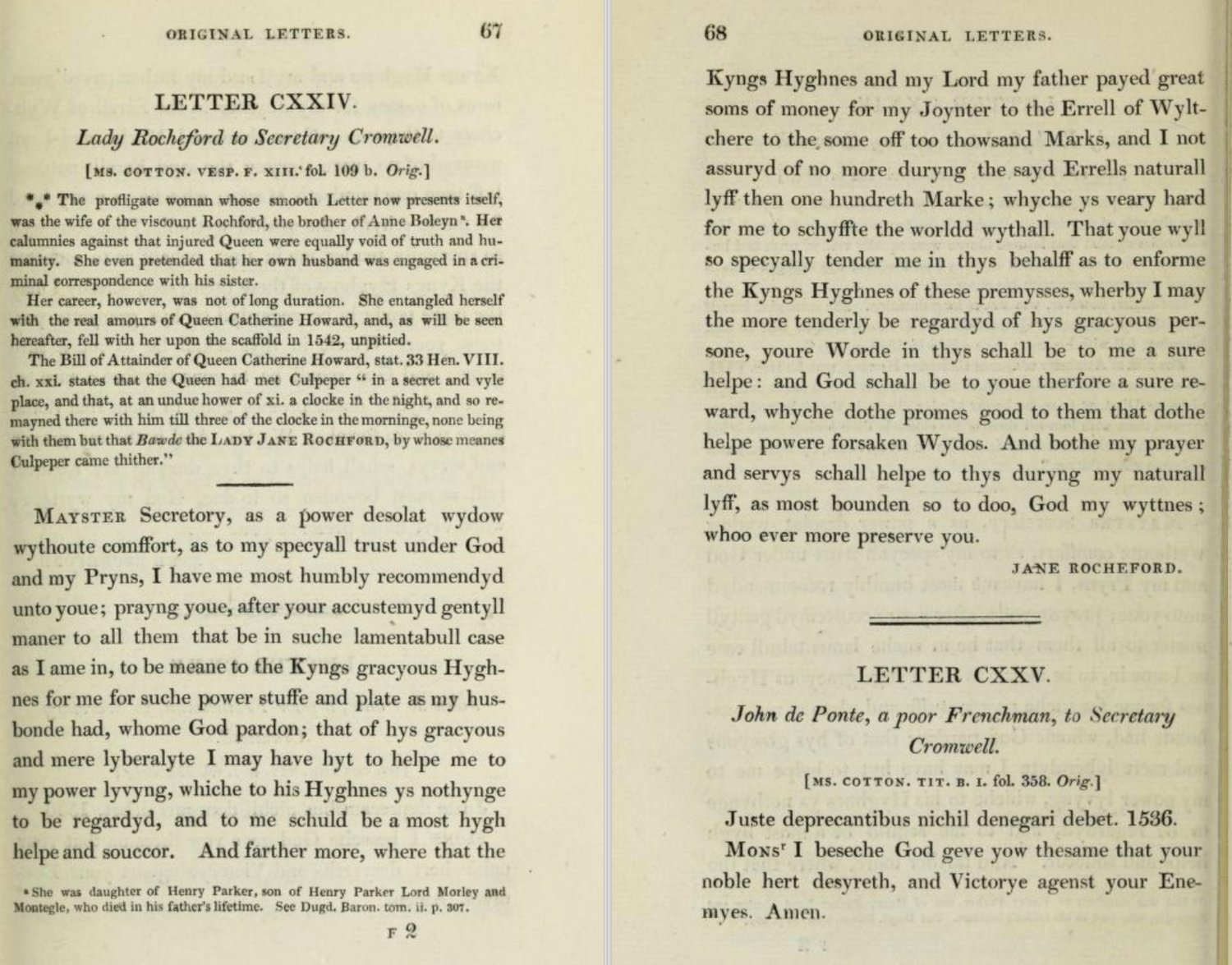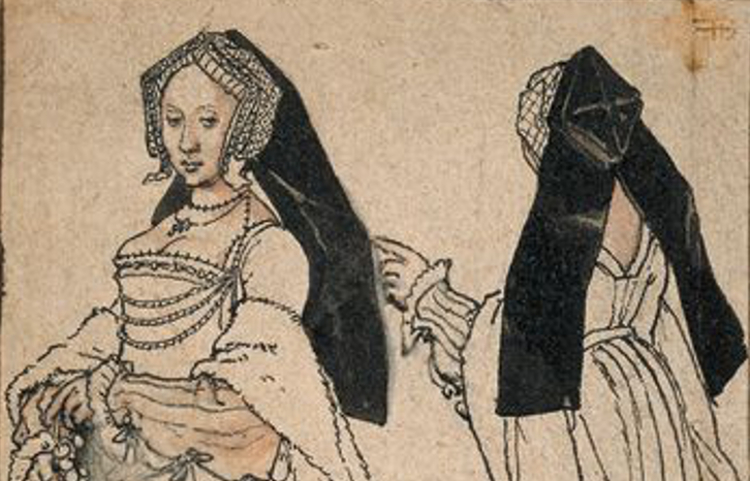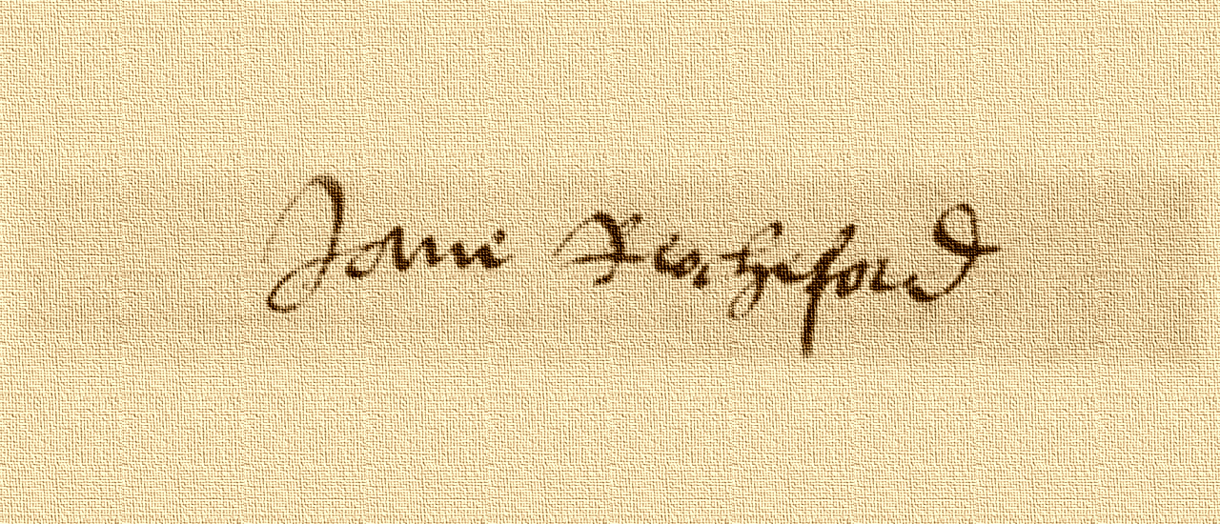It is also the case that Lady Rochford’s interests as a widow were carefully looked after by Cromwell
Eric Ives The Life and Death of Anne Boleyn 1
While we have evidence that Thomas Cromwell assisted Jane Boleyn after she was widowed in some scant capacity, I quote Eric Ives from a section of his Anne Boleyn biography where he has suggested that Jane gave evidence against Anne and George, either out of jealousy over their relationship, or her loyalty to Princess Mary.Using an absolute statement, Ives begins by claiming ‘George did respond to the evidence of another court lady, his own wife Jane’.2 He uses two sources for this, the first, the Lancelot De Carles poem, in which George allegedly said ‘On the evidence of only one woman you are willing to believe this great evil of me’, and an anonymous foreign visitor’s account which claimed ‘that person who more out of envy and jealousy than out of love towards the king did betray this accursed secret and together with it the names of those who had joined in the evil doings of the unchaste queen’3
LI suggest that the De Carles poem and the anonymous source, the ‘one woman’ and ‘that person’, refers only to Lady Wingfield, who Ives also discusses. We have corroborating evidence that Lady Wingfield provided some sort of testimony against Anne and George, from a judge who took part in the trial. De Carles’ poem and the anonymous source mean little in relation to Jane. Neither source names Jane. The sources name ‘one woman’ and ‘that person’. They do not say ‘Lady Rochford’ or ‘Rochford’s wife’. They are not a source for Jane’s testimony. They have been used by many historians to shape a theory in the absence of evidence.
It is very clear that Eric Ives believed that Jane was also involved in the coup against the Boleyn siblings, and is able to persuade the reader, simply with the power of that conviction. Ives looked more closely at the marriage of Henry and Anne than any historian had done before, and in examining the breakdown of the marriage, like so many others, tried to find more plausible answers for Henry’s abrupt decision to execute his wife. I would suggest that Ives wanted Henry to have been misled in some capacity, so that it is not flat-out murder. I, on the other hand, recognise patterns of domestic violence in Henry’s behaviour that we simply wouldn’t have been discussing forty years ago, and people are still uncomfortable discussing now. It is not present-centred, however, to state that Henry VIII carried out acts of domestic violence.
Ives suggested that Jane’s alleged testimony was perhaps what prompted Cromwell to assist her. Now, it is a fact, as far as we can demonstrate, that Cromwell assisted Jane when she wrote to him for help. We have two letters in relation to this, one from Jane pleading with Cromwell for assistance with the jointure owed to her from her father-in-law, and an answer from Thomas Boleyn. I rule out that Jane was promised remuneration prior to any testimony, as is sometimes imagined in fiction, as her letter is begging Cromwell for assistance. The letter is filed in May 1536 in Letters and Papers, and is reproduced in full here by Henry Ellis.4

What exactly is Jane asking for here? A jointure was an agreed upon monetary sum or lands paid by the father of the bride to ensure her an income, should her husband predecease her. Thomas Boleyn negotiated a staggering 2000 marks, almost £1300, hundreds of thousands of dollars in today’s currency, and Jane’s father, Lord Morley, wasn’t in the position to pay the entire sum.5 Henry VIII himself paid 1000 marks towards the jointure.6 This was not at all unusual for a favourite, as young George Boleyn was with Henry VIII. Widows were usually given an annual payment of ten percent of the original amount paid for the jointure. Thomas Boleyn somehow contrived to contract only 100 marks per annum for Jane’s jointure, ten percent of what Lord Morley paid, but not of the entire amount Thomas Boleyn received. This is the complaint that Jane is raising. She was entitled to double the amount that Thomas Boleyn had specified in the contract.
Cromwell obviously did approach Henry about the matter, and Thomas Boleyn replied promptly to Henry’s letter.
I received a letter from the King, with another from you concerning an augmentation of living to my daughter of Rochford; and although my living of late is much decayed, I am content, whereas she now has 100 marks a year, and 200 marks a year after my decease, to give her 50 marks a year more in hand. From Lady day last past she shall have 100l. a year to live on, where she should have had only 100 marks as long as I live, and after my death 300 marks a year. Beseeching you to inform the King that I do this alonely for his pleasure. When I married I had only 50l. a year to live on for me and my wife as long as my father lived, and yet she brought me every year a child. I thank you for your goodness to me when I am far off, and cannot always be present to answer for myself. Hever, this first Sunday of July.7
From the above two letters, supported by research undertaken by Julia Fox, who discovered the original prenuptial contract that was drawn up on October 4, 1524, outlining Jane’s marriage settlement, we can recreate the following ‘reality’. Jane’s jointure was supplemented by Henry VIII. Thomas Boleyn, likely not expecting to have to pay out this jointure in his lifetime, only allotted Jane ten percent of the sum her father paid, and not of the full sum he received. Julia Fox also notes that Thomas allotted lands to Jane that technically still belonged to his mother, Margaret Boleyn’s Ormond inheritance, but that it would not have been a problem if George lived to a reasonable age.8 The jointure specified rents from lands or an annual income. Faced with the income of only 100 marks per annum, or £66, Jane wrote to Cromwell to throw herself on his mercy. Cromwell must have approached Henry promptly, who wrote to Thomas Boleyn. Thomas swiftly agreed to increase her income to 150 marks per annum, and 300 marks after his death.
This is a very small scrap of reality in Jane’s life that we can create from sources. It’s not particularly remarkable, on the surface. A discrepancy in her marriage contract was raised, and it was resolved to her satisfaction. Further analysis of the language used in the letters, and the dates, along with a contemporary incident that may have influenced Jane seeking Cromwell’s help constructs more of a story. I’m now going to conjecture why Jane wrote to Cromwell, and why Cromwell and Henry VIII assisted her.
Jane writes to Cromwell because of his ‘accustomed gentle manner to all them that be in such lamentable case as I am in’. Although this letter is filed May 1536, it is likely the letter was written in June. Thomas Boleyn’s reply was July 2nd, immediately after receiving Henry VIII’s letter. It could have, of course, taken several weeks for Henry to take action, but there is another source from June, the allotted grants of that month, that is of more interest. The widow of William Brereton, Elizabeth, was granted all of the lands that William had held before he was attainted and executed in the coup against Anne Boleyn. William was one of the five men accused of committing adultery with Anne. It has long been supposed that Brereton, who was not part of Anne’s inner circle, was a political victim of Cromwell’s.
Eliz. Savage, widow of Sir John Savage and late wife of Wm. Brereton, deceased, attainted of high treason. Grant of all the goods and chattels, rents, fees, and annuities belonging to the said William at the time of his attainder, all debts then due to him, all deeds and obligations wherein any one was bound to him, and the issues of all the possessions which he held in right of her the said Elizabeth.9
Elizabeth would write to Cromwell again that November, sending him a gelding as she sought assistance from him again.10 I conclude that it is very likely that Jane, upon hearing that Cromwell had assisted Elizabeth, thought it a good time to approach Cromwell about her issue with her jointure. One hundred marks was more than enough for many families to live on, but a courtier’s life was expensive. It is likely Jane already knew, when she wrote for assistance, that she would have to return to court eventually, and would need the income to do so. She referenced Cromwell’s generosity in helping others in her letter. As we can see, Jane also asked for personal items of George’s, some of the plate may be seen in an inventory of her possessions taken after her death.11 If Jane wrote to Cromwell in June, this indicates a timely response, with Thomas Boleyn receiving a letter and responding on July 2nd. Why do I think the date is important? I want to emphasise that Cromwell, who helped hundreds of courtiers over the course of his career, assisted another woman he had helped make a widow. Perhaps that is what gave Jane the confidence to ask for help, in the traumatic weeks following the fall of Anne Boleyn, the death of her husband, and what Jane may have perceived as the destruction of her own life.
While Henry was redistributing George Boleyn’s lands mere weeks after his death, and Elizabeth Savage was granted everything that had belonged to her late husband, Jane was scrabbling for her bed and some plate, and another 50 marks a year. She didn’t even secure the full amount of her jointure, only £100 per annum rather than the £130 she should have been granted. So can we see this as a ‘reward’ for Jane’s alleged involvement in the coup against Anne Boleyn? There is no compelling evidence that Jane received any special treatment at all. Why Henry VIII intervened on Jane’s behalf likely has little to do with benevolence. We can see that Henry enjoyed forcing Thomas Boleyn to play the dutiful courtier after he murdered Thomas’s children. Henry forced Thomas to attend the christening of Edward VI, tasked with bearing a taper of virgin wax in a towel hung around his neck,12 bearing witness to Henry’s triumph. Thomas Boleyn had paid dearly for that triumph, bought with the death of his children. Henry VIII was nothing if not spiteful.

- E. Ives, The Life and Death of Anne Boleyn, Second Edition, (Oxford: Blackwell, 2004) 332 ↩
- E. Ives, The Life and Death of Anne Boleyn, (Second Edition, Oxford: Blackwell, 2004) 331. ↩
- Ives, Anne Boleyn, 331 ↩
- H. Ellis, H. Ellis Original Letters Illustrative of English history… Series I Vol II (London:Harding, Triphook & Lepard, 1825) 67-68. ↩
- [Julia Fox has suggested Lord Morley may have paid the jointure in instalments, as a record of payment to Thomas Boleyn for £33l. 6s. 8d may indicate in ‘Letters and Papers, Foreign and Domestic, Henry VIII, Volume 9, August-December 1535’, British History Online, Appendix #99. ↩
- J. Fox, Jane Boleyn: The True Story of Lady Rochford, (New York: Ballantine 2008) 31-32. ↩
- L&P Vol XI #17. ↩
- Fox, Jane Boleyn, 33. ↩
- L&P Vol X #1256. ↩
- L&P XI #1024 ↩
- J.A. Rowley-Williams, Image and Reality: The Lives of Aristocratic Women in Early Tudor England, Doctoral Thesis, (University of Wales, Bangor, 1998) 299. ↩
- L. Mackay, Among the Wolves of the Court, ( London: I.B. Tauris, 2018)222. ↩

